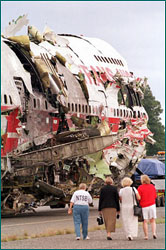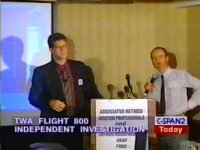
| |
A National Transportation Safety Board official walks with three family members of TWA Flight 800 victims near the wrecked plane's partially reconstructed fuselage (PBS.org photo/caption).
|
TWA Flight 800: An Introduction
Present Status
The official theory for the crash is no longer viable. The initial detonation captured by multiple radar sites that blew debris at supersonic speeeds away from the aircraft shown in detail here excludes the official theory of a fuel-air explosion as the cause of the crash. The National Transportation Safety Board (NTSB) concluded and all relevant government scientists agree that the fuel-air explosion was low-velocity. Such an explosion could not have launched debris at supersonic speeds in any direction.
The NTSB has not yet responded to multiple requests regarding the high-velocity debris recorded by multiple FAA radar sites. Neither the NTSB final report, nor any factual or other report in the 13,000 page public docket contains any analysis of this initial radar-recorded detonation--the very explosion that caused the crash.
As described here, the government's explanation for the many eyewitness reports of a rising streak of light was the plane climbing sharply after breaking in two. However radar tracking of the accident aircraft recorded no such climb. This leaves nothing in the official theory to explain nearly 200 eyewitnesses accounts.
As reported here, "NTSB Chairman Hall addressed the data showing that Flight 800 did not climb during the final hearing on TWA Flight 800 in August 2000. Hall asked Witness Group Chairman Dr David Mayer: “Now, if you could show that the airplane did not climb after the nose departed, will that change your analysis?” Mayer responded, “No sir...” Chairman Hall did not ask Mayer why his analysis would not change if the evidence showed that Flight 800 did not climb.
When Hall asked Mayer if he would change his conclusion if the evidence indicated that a different scenario was valid and Mayer responded that he would not, Mayer was being scientifically dishonest."
Background
TWA Flight 800 crashed off the coast of Long Island in July 1996. Witness accounts of a rising streak of light seen before the crash raised concerns that a missile may have been involved. But after a four-year investigation, the National Transportation Safety Board (NTSB) concluded that the rising streak was simply the plane itself, in flames. The official cause "could not be determined with certainty."
The NTSB investigation was severely hampered by the FBI, who repeatedly denied the NTSB access to forensic and eyewitness evidence. The NTSB interviewed fewer than two percent of the 670 eyewitnesses, and during its final hearing on the crash, failed to account for 86 % of the witnesses with detailed decriptions of the rising streak.
In the end, federal investigators provided few conclusive findings and left many questions unanswered.
Unanswered Questions
Questionable Answers
Besides leaving questions unanswered, federal investigators proposed many questionable answers.
- The NTSB said that a well-observed rising streak was Flight 800 itself, after its forward fuselage separated from the rest of the plane. But witnesses said the streak rose "up from the ground toward the aircraft" and collided with Flight 800 before the front section fell off.[Witness 73]
- The FBI said that traces of explosives found in the wreckage were accidentally spilled inside the aircraft weeks before the crash. But some of the traces were found outside the aircraft, on the right wing.
- Officials explained the anomalous recovery location of a debris item (CW-504) by saying it may have spun like a helicopter blade. Investigators did not address the coincidental presence of nitrates on this item. An explosive event not associated with aircraft fuel could account for the object's recovery location and the nitrate presence.
- For more questionable answers and unanswered questions, see this petition to the NTSB, submitted by Flight 800 Independent Researchers Organization (FIRO).
 | |
FIRO Chairman Tom Stalcup (left) on FIRO FOIA Officer Graeme Sephton at an August 1999 press conference in Washington DC.
|
Informed Citizens = Safer Skies
The purpose of this website is to inform the public of significant lapses in the official Flight 800 investigation that led to the release of an inconclusive and incomplete final report. FIRO believes that citizens informed on matters related to aviation safety can help make air-travel safer.
FIRO's petition to the NTSB is publicly available in Internet-friendly format, and lists evidence in conflict with, and not addressed in the NTSB's Flight 800 crash report.
The reader is urged to be objective and diligent, for this is a complex case, with many details. A good starting point is to learn about the government's handling of the eyewitness evidence.
Observations Explained?
July 17, 1996 was a calm and beautiful day on Long Island. At 8:30 PM, the sun had just set as many on the South-shore gazed into
the dimming horizon.
Witness 73 "removed her shoes
and walked down to the water line where she enjoyed the ocean for a while." A little later, "her attention was drawn
to an aircraft that was flying from her right to her left...[and then] she noticed what
appeared to be a 'contrail' which appeared to be coming from an object which was flying
toward the plane which she had been watching." She said the object was a "'red streak' moving up from the ground toward the aircraft at an approximately a 45 degree angle.
At the instant the smoke trail ended at the aircraft's right wing, she heard a loud sharp noise which sounded like a firecracker had just exploded at her feet. She then observed a fire at the aircraft followed by one or two secondary explosions which had a deeper sound. She then observed the front of the aircraft separate from the back."
The official FBI summary of Witness 73's account is one of the most detailed in existence. She witnessed the entire event: Flight 800 heading east; an object rising from the surface; the object's 2.6 mile ascent; its collision with Flight 800; primary and secondary explosions; the separation of the forward fuselage; and the fiery descent to the surface.
And what makes Witness 73 credible is her description of the forward fuselage separating from the rest of the aircraft. This event, depicted in government animations, was confirmed by Navy salvage teams who recovered the front fuselage over one mile away from the rest of the plane. Federal investigators have since determined that the forward section separated from the aircraft within four seconds of the initial explosion.[NTSB Exhibit 7A]
But strangely, officials say that the object Witness 73 saw rise up and hit the plane was actually the plane itself, after the front section fell off. Meanwhile, all of the witness documents, including Witness 73's, were withheld from the public for four years.
When the eyewitness evidence was finally released, FIRO conducted a thorough review of the documents and found over 100 eyewitnesses whose accounts conflicted with the official crash scenario, and twenty-one who, like Witness 73, reported two distinct objects in the air before Flight 800 exploded.
For more information on the handling of eyewitness evidence, read this article.
The Baltimore Hearing
The NTSB held a week-long public hearing for the crash in Baltimore, which began on December 8, 1997. The eyewitness accounts were among the items slated for discussion. However, just days before the hearing,
the FBI pressured the NTSB to ban all eyewitness testimony and discussion.
In a December 3, 1997 letter addressed to NTSB
Chairman Hall, then FBI Assistant Director James Kallstrom wrote:
"…Set forth below are the specific parts
of the hearing, as set forth in the 11/29/97 5:56 AM draft Witness
list, to which we [the FBI] object and the bases for our objections.
Review of Witness Statements Panel
the FBI objects to requests to disclose
or include in the public docket of any FBI FD-302s or summaries
of FD-302s prepared by the NTSB that report the results of any
interviews or reinterviews of the 244 eyewitnesses whose reports
were examined by the CIA in connection with it's analysis and
to calling any eyewitnesses to testify at the public hearing"
Also stricken from the hearing was evidence supporting an external cause for the crash. Kallstrom's letter continued, listing further objections to hearing items:
"Investigation For Missile/Warhead Impact/Bombs/Explosives;
Residue Examination (exhibit 20I); PETN Findings, Small Explosive
Charges
we particularly object to discussion of
the residue examination and the use of exhibit 20I, an FBI Laboratory
report on the chemical analysis of the residue found on the seats."
Evidence Banned
Without even a day to consider the letter or to consult with investigators, NTSB Chairman Jim Hall responded with a letter (dated the same day as Kallstrom's letter) offering compliance with the FBI requests. In the end, all eyewitness testimony and much of the physical evidence supporting an external cause for the crash was banned from the hearing.
This unprecedented decision sparked the formation of Flight 800 Independent Researchers Organization (FIRO), a group dedicated to researching and publicizing evidence banned or neglected by federal investigators.
Presently, FIRO is petitioning the NTSB to reconsider its findings and suing the FBI for forensic analyses it is withholding from the public in apparent violation of FOIA laws.
All readers are urged to write their representatives
in Washington, D.C. asking them to request the NTSB to thoroughly consider and adequately respond to FIRO's petition.
The petition may be viewed online, in a web-based format
http://www.flight800.org/petition/pet_contents.htm
or can be downloaded for printing
Printable version of petition.
Present Status (repeated from above)
The official theory for the crash is no longer viable. The initial detonation captured by multiple radar sites that blew debris at supersonic speeeds away from the aircraft shown in detail here excludes the official theory of a fuel-air explosion as the cause of the crash. The National Transportation Safety Board (NTSB) concluded and all relevant government scientists agree that the fuel-air explosion was low-velocity. Such an explosion could not have launched debris at supersonic speeds in any direction.
The NTSB has not yet responded to multiple requests regarding the high-velocity debris recorded by multiple FAA radar sites. Neither the NTSB final report, nor any factual or other report in the 13,000 page public docket contains any analysis of this initial radar-recorded detonation--the very explosion that caused the crash.
As described here, the government's explanation for the many eyewitness reports of a rising streak of light was the plane climbing sharply after breaking in two. However radar tracking of the accident aircraft recorded no such climb. This leaves nothing in the official theory to explain nearly 200 eyewitnesses accounts.
As reported here, "NTSB Chairman Hall addressed the data showing that Flight 800 did not climb during the final hearing on TWA Flight 800 in August 2000. Hall asked Witness Group Chairman Dr David Mayer: “Now, if you could show that the airplane did not climb after the nose departed, will that change your analysis?” Mayer responded, “No sir...” Chairman Hall did not ask Mayer why his analysis would not change if the evidence showed that Flight 800 did not climb.
When Hall asked Mayer if he would change his conclusion if the evidence indicated that a different scenario was valid and Mayer responded that he would not, Mayer was being scientifically dishonest."
FIRO's Main Page - Email this URL to a friend 
© MMIII
|